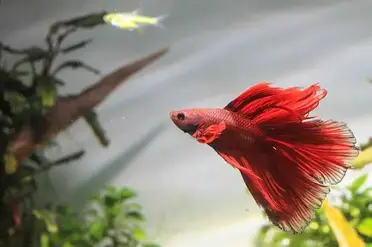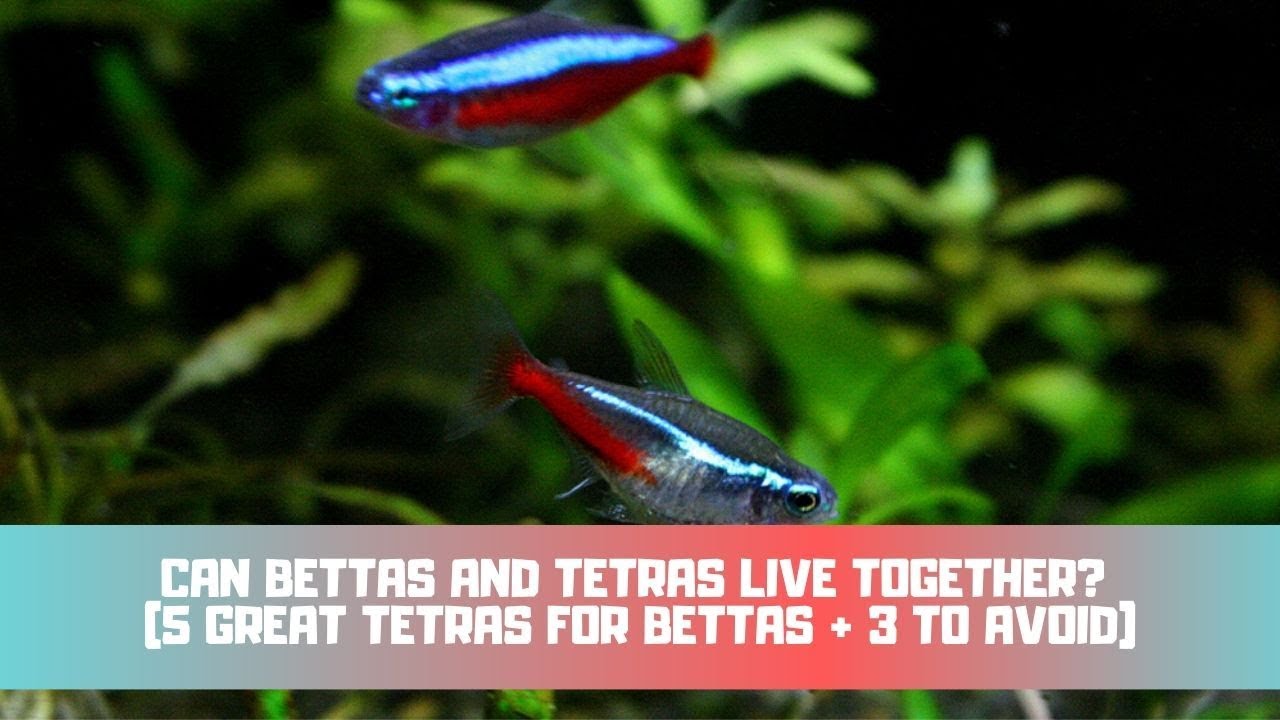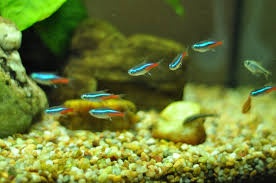
Tetras and bettas are both popular choices for aquarium enthusiasts, but can they live together peacefully?
Many aquarists have wondered about the compatibility of these two fish species, as they have different temperaments and water requirements. Tetras are known for their schooling behavior and active swimming, while bettas are solitary fish with long, flowing fins. Despite these differences, it is possible to create a harmonious environment for both tetras and bettas in the same aquarium.
Before introducing tetras to a betta tank, it’s important to consider a few factors to ensure a peaceful coexistence.
Water parameters: Bettas prefer warmer water with a temperature range of 75-82°F (24-28°C), while tetras thrive in slightly cooler water with a temperature of 72-78°F (22-26°C). It’s crucial to maintain a stable water temperature that falls within the suitable range for both species to prevent stress or illness.
Tank size: Providing enough space is essential for the well-being of both tetras and bettas. A larger tank, ideally 20 gallons or more, will offer more swimming space and territories for each fish. The additional space will also help reduce territorial behavior and aggression, promoting a peaceful coexistence.
Group size: Tetras are shoaling fish that thrive in groups. Keeping tetras in larger groups of at least six individuals will help distribute their activity and divert attention away from the betta. This will reduce the chances of the betta feeling threatened or stressed.
Introducing tetras to a betta tank requires careful observation and monitoring.
When adding tetras to an established betta tank, it’s recommended to introduce them after the betta has acclimated to its new environment. This will allow the betta to establish its territory and reduce the likelihood of aggression towards the tetras. Additionally, adding tetras of similar size and coloration to the betta’s fins can help minimize the betta’s aggression.
Regular supervision is necessary during the initial introduction phase to ensure that the betta does not become overly aggressive towards the tetras. If aggression is observed, it may be necessary to separate the fish temporarily or rearrange the tank to provide more hiding spots and break the betta’s line of sight.
In conclusion, with proper planning and consideration, tetras and bettas can coexist peacefully in the same aquarium.
Providing suitable water conditions, sufficient space, and a well-thought-out introduction strategy will help minimize aggression and create a harmonious environment for both species. However, it’s important to remember that individual fish behavior can vary, and careful monitoring is necessary to ensure the well-being of all tank inhabitants. By following these tips, aquarists can enjoy the beauty and diversity of both tetras and bettas in the same tank.
Understanding the Nature of Tetras and Bettas
Before considering keeping tetras and bettas together in an aquarium, it is important to understand the nature and behavior of both species. This will help you create a suitable environment that can promote a peaceful coexistence between them.
Tetras, known for their vibrant colors and lively nature, are small schooling fish that prefer to live in groups. They are active swimmers and tend to occupy the middle and upper levels of the aquarium. Tetras are generally peaceful, but their small size can sometimes make them targets for larger, more aggressive fish.
Bettas, also known as Siamese Fighting Fish, are highly territorial and aggressive towards other males of their kind. They have long, flowing fins and come in various colors. Male bettas are especially known for their aggression, which makes them unsuitable tankmates for most other fish species.
While tetras can be compatible with bettas, it is crucial to choose the right tetra species and create a suitable environment for them to coexist harmoniously. Avoid combining tetras with long-finned bettas, as the betta might mistake their flowing fins for another male betta and attack them.
Additionally, it is essential to provide ample hiding spots and plants in the aquarium to break line of sight and create separate territories for both species. This will help reduce aggression and stress. Providing plenty of space and a well-balanced diet for both tetras and bettas is also vital for their overall health and well-being in a shared tank.
Understanding the nature of tetras and bettas is key to creating a peaceful aquarium environment where these two species can coexist. With proper research, planning, and careful observation, it is possible to successfully keep tetras and bettas together, adding beauty and variety to your aquarium.
Factors to Consider Before Keeping Tetras and Bettas Together
Before deciding to keep tetras and bettas together in the same aquarium, there are several important factors to consider. These factors can greatly affect the success of keeping these two fish species together and ensuring a peaceful and harmonious tank environment.
1. Tank Size: Both tetras and bettas have specific space requirements. Tetras are schooling fish and require a minimum tank size of 10 gallons to provide adequate swimming space. On the other hand, bettas are solitary fish and can thrive in smaller tanks, but a minimum size of 5 gallons is recommended. The tank should be large enough to accommodate both fish comfortably.
2. Water Parameters: Tetras and bettas have different preferences when it comes to water parameters. Tetras prefer slightly acidic to neutral water with a pH range of 6.5-7.5. They also appreciate soft to moderately hard water with a temperature range of 72-78°F (22-26°C). Bettas, on the other hand, prefer slightly acidic water with a pH range of 6.0-7.5 and a temperature range of 76-82°F (24-28°C). It is important to ensure that the tank’s water parameters are suitable for both species.
3. Tank Decorations: The tank should be properly decorated to provide hiding spots and visual barriers for both tetras and bettas. This will help alleviate stress and reduce aggression between the two species. Live plants, driftwood, and rocks can provide suitable hiding places for both fish. Ensure that the decorations do not have sharp edges that could potentially harm the delicate fins of bettas.
4. Aggression and Compatibility: Bettas are known for their aggression towards other fish, especially those with colorful fins, such as tetras. However, the temperament of bettas can vary greatly, and some individuals may be more tolerant of tankmates than others. It is essential to monitor the behavior of the betta and tetras closely to ensure their compatibility. If any signs of aggression or stress are observed, it may be necessary to separate them into different tanks.
5. Feeding Considerations: Bettas are carnivorous and primarily eat small insects and their larvae. Tetras, on the other hand, are omnivorous and have a varied diet that includes both plant matter and small invertebrates. When feeding both species together, it is important to provide a balanced diet that meets the nutritional needs of both fish. Ensure that the food is small enough for both tetras and bettas to consume easily.
By considering these factors carefully and providing the appropriate tank conditions, it is possible to successfully keep tetras and bettas together in the same aquarium. However, it is always important to monitor their behavior closely and be prepared to separate them if any issues arise.
Creating the Perfect Environment for Tetras and Bettas

Having a peaceful and harmonious aquarium with tetras and bettas requires careful attention to the environment and conditions in which they live. Taking the following steps will help create a perfect environment for both species:
1. Aquarium Size:
Make sure to provide an aquarium of adequate size to accommodate both tetras and bettas comfortably. A tank size of at least 20 gallons is recommended to ensure enough space and hiding spots.
2. Water Parameters:
Tetras and bettas have slightly different water requirements. Maintain a temperature between 74-78°F (23-26°C) and a pH level around 6.5-7.5. Regularly test and monitor water quality to ensure optimal conditions.
3. Filtration and Aeration:
Good filtration and aeration are crucial to maintain clean and oxygenated water. Use a filter that provides gentle water flow and avoids creating strong currents, as this can stress bettas. Additionally, consider adding an air stone or other aeration device to increase oxygen levels.
4. Plants and Decorations:
Incorporate live plants and suitable decorations to provide hiding spots and naturalistic environment, which can help reduce aggression between tetras and bettas. Choose plants such as Java moss, Anubias, or Amazon sword that can thrive in the tank’s conditions.
5. Line of Sight Breakers:
Tetras and bettas are both territorial and may feel threatened by each other’s presence. Use plants, rocks, or other decorations to create line of sight breakers, allowing the fish to establish their own territories and reducing potential conflicts.
6. Feedings:
Ensure both tetras and bettas are provided with appropriate and varied diets. Tetras are omnivorous and will appreciate a mix of flakes, pellets, and live or frozen foods. Bettas are carnivorous and prefer high-quality pellets or frozen foods. Avoid overfeeding to prevent water quality issues.
7. Monitoring Behavior:
Closely observe the behavior of both tetras and bettas to identify any signs of aggression or stress. If any conflicts arise, rearrange decorations or separate the fish if necessary.
By following these tips and creating a suitable environment, tetras and bettas can coexist peacefully in the same aquarium, bringing beauty and diversity to your underwater world.
Introducing Tetras to an Established Betta Aquarium
When adding tetras to an established betta aquarium, there are several important steps to take to ensure a smooth and peaceful transition. By following these guidelines, you can significantly reduce the risk of aggression or stress among your fish.
1. Prepare the tetra for introduction
Before adding tetras to your betta aquarium, it is crucial to quarantine them in a separate tank. This helps prevent the spread of any potential diseases or parasites. Make sure to observe the tetras for a week or two to ensure they are healthy and free from any issues.
Additionally, it is essential to acclimate the tetras to your betta’s water parameters slowly. Gradually introduce small amounts of your betta aquarium water to the quarantine tank over several days to allow the tetras to adjust to the new environment.
2. Rearrange the aquarium
Prior to introducing the tetras, consider rearranging the decorations and plants in your betta aquarium. This will eliminate the established territories and reduce aggression from the betta, who might feel threatened by the new additions. Creating hiding spots for both the betta and tetras can provide a sense of security for all the fish.
It is recommended to add the tetras first, as they are generally faster swimmers and can establish their territories before the betta. This can help prevent the betta from perceiving the tetras as intruders and reduce the likelihood of aggression.
3. Monitor and observe

After introducing the tetras, closely monitor the behavior of all the fish in the aquarium. Look out for any signs of aggression or stress, such as fin nipping, chasing, or excessive hiding. It is normal for the betta to establish dominance and chase the tetras initially, but if the aggression persists, you may need to reconsider the compatibility of these fish.
Ongoing observation is essential to ensure a peaceful coexistence between the tetras and the betta. If any issues arise, be prepared to separate the fish into different tanks or provide alternative housing options to ensure their well-being.
Note: All fish have differing personalities and temperaments, so it is not guaranteed that all bettas and tetras will get along. It is important to remember that there is always a risk when introducing new fish to an established aquarium. However, by following these guidelines and closely monitoring the situation, you can increase the chances of a successful and harmonious community tank.
Introducing Bettas to an Established Tetra Aquarium
Introducing bettas to an established tetra aquarium can be a delicate process that requires careful planning and monitoring. It is important to consider the temperament and compatibility of both species to ensure a peaceful and harmonious environment for all the tank inhabitants.
Here are some tips to help you successfully introduce bettas to your established tetra aquarium:
- Preparation: Before introducing the bettas, it is crucial to ensure that the tetra aquarium is properly set up and maintained. This includes having appropriate water conditions, a well-established nitrogen cycle, and suitable hiding places and plants for the tetras to feel safe.
- Observation: Before adding the bettas, carefully observe the behavior of the tetras. If they are aggressive or nip at each other, it is best not to introduce the bettas to the tank as it may lead to conflicts and stress for both species.
- Separation: If the tetras show peaceful behavior, it is advisable to introduce a temporary barrier in the tank to separate the bettas from the tetras initially. This can be done using a transparent divider or by adding a separate small container within the tank. This allows for proper acclimation and adjustment between the two species.
- Gradual Introduction: After a few days of separation, start gradually introducing the bettas to the tetra aquarium. This can be done by removing the barrier for short periods and closely monitoring their interactions. If any signs of aggression or stress are observed, immediately return the bettas to their separate container.
- Feeding: Since bettas are known to be aggressive feeders, it is important to ensure that all the tank inhabitants receive enough food. Consider feeding multiple small meals throughout the day or using sinking pellets to ensure that the tetras have an opportunity to eat without interference from the bettas.
- Monitoring: After the bettas have been introduced, closely monitor their behavior and interactions with the tetras. If any signs of aggression or stress persist, it may be necessary to separate the bettas permanently or rehome them to a suitable alternative habitat.
Remember, every aquarium is unique, and the compatibility between bettas and tetras can vary. It is important to observe and understand the behavior of each individual fish and make informed decisions based on their welfare and well-being.
Question and answer:
Can tetras and bettas be kept together in the same aquarium?
Yes, tetras and bettas can be kept together in the same aquarium as long as certain measures are taken to ensure compatibility and prevent aggression.
Are tetras and bettas compatible tank mates?
Tetras and bettas can be compatible tank mates if the aquarium is properly set up and enough space is provided for both species to establish their territories.
What can I do to create a peaceful aquarium with tetras and bettas?
To create a peaceful aquarium with tetras and bettas, you should provide plenty of hiding places, avoid overstocking, and introduce the fish to the tank at the same time to prevent territorial disputes.
Are there any specific tetra species that can coexist peacefully with bettas?
Some tetra species that can coexist peacefully with bettas include neon tetras, ember tetras, and black skirt tetras. It’s important to research the specific needs and temperaments of each tetra species to ensure compatibility.
What should I do if my tetras and bettas are showing signs of aggression towards each other?
If your tetras and bettas are showing signs of aggression towards each other, you should consider separating them into different tanks or removing the aggressive fish from the tank. It’s important to prioritize the well-being of all the fish in your aquarium.